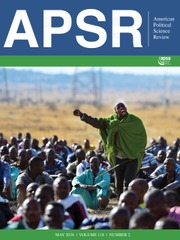Crossref Citations
This article has been cited by the following publications. This list is generated based on data provided by
Crossref.
Prato, Carlo
and
Wolton, Stephane
2012.
Electoral Competition, Costly Campaigns, and Independent Political Expenditure.
SSRN Electronic Journal,
Jha, Saumitra
2013.
Analyzing political risks in developing countries: a practical framework for project managers.
Business and Politics,
Vol. 15,
Issue. 1,
p.
117.
Spierings, Niels
and
Jacobs, Kristof
2014.
Getting Personal? The Impact of Social Media on Preferential Voting.
Political Behavior,
Vol. 36,
Issue. 1,
p.
215.
Broockman, David E.
and
Green, Donald P.
2014.
Do Online Advertisements Increase Political Candidates’ Name Recognition or Favorability? Evidence from Randomized Field Experiments.
Political Behavior,
Vol. 36,
Issue. 2,
p.
263.
Boddery, Scott S.
and
Yates, Jeff
2014.
Do Policy Messengers Matter? Majority Opinion Writers as Policy Cues in Public Agreement with Supreme Court Decisions.
Political Research Quarterly,
Vol. 67,
Issue. 4,
p.
851.
Bowen, Daniel C.
2014.
Boundaries, Redistricting Criteria, and Representation in the U.S. House of Representatives.
American Politics Research,
Vol. 42,
Issue. 5,
p.
856.
Akirav, Osnat
2015.
Re-election: Different Skills for Different Roles.
Government and Opposition,
Vol. 50,
Issue. 1,
p.
90.
Grose, Christian R.
Malhotra, Neil
and
Parks Van Houweling, Robert
2015.
Explaining Explanations: How Legislators Explain their Policy Positions and How Citizens React.
American Journal of Political Science,
Vol. 59,
Issue. 3,
p.
724.
Christenson, Dino P.
and
Glick, David M.
2015.
Chief Justice Roberts's Health Care Decision Disrobed: The Microfoundations of the Supreme Court's Legitimacy.
American Journal of Political Science,
Vol. 59,
Issue. 2,
p.
403.
Fowler, Anthony
and
Hall, Andrew B.
2015.
Congressional seniority and pork: A pig fat myth?.
European Journal of Political Economy,
Vol. 40,
Issue. ,
p.
42.
Clifford, Scott
Jewell, Ryan M
and
Waggoner, Philip D
2015.
Are samples drawn from Mechanical Turk valid for research on political ideology?.
Research & Politics,
Vol. 2,
Issue. 4,
BOND, ROBERT
and
MESSING, SOLOMON
2015.
Quantifying Social Media’s Political Space: Estimating Ideology from Publicly Revealed Preferences on Facebook.
American Political Science Review,
Vol. 109,
Issue. 1,
p.
62.
Braidwood, Travis
2015.
Desirable pork: do voters reward for earmark acquisition?.
Research & Politics,
Vol. 2,
Issue. 4,
Hamad, Rita
Pomeranz, Jennifer L.
Siddiqi, Arjumand
and
Basu, Sanjay
2015.
Large-scale automated analysis of news media: A novel computational method for obesity policy research.
Obesity,
Vol. 23,
Issue. 2,
p.
296.
Parkinson, Sarah E.
2016.
Money Talks: Discourse, Networks, and Structure in Militant Organizations.
Perspectives on Politics,
Vol. 14,
Issue. 4,
p.
976.
Heinrich, Tobias
Kobayashi, Yoshiharu
and
Peterson, Timothy M.
2016.
Sanction Consequences and Citizen Support: A Survey Experiment.
International Studies Quarterly,
p.
sqw019.
Hollibaugh, Gary E.
2016.
Presidential Appointments and Public Trust.
Presidential Studies Quarterly,
Vol. 46,
Issue. 3,
p.
618.
Hassell, Hans J.G.
and
Monson, J. Quin
2016.
Representational Inconsistency: Presentation of Self and Explanations of Washington Activity in Campaign Mail and Franked Mail.
Congress & the Presidency,
Vol. 43,
Issue. 2,
p.
206.
Lee, Frances E.
2016.
Governing in a Polarized Age.
p.
115.
Jacobs, Kristof
and
Spierings, Niels
2016.
Saturation or maturation? The diffusion of Twitter and its impact on preference voting in the Dutch general elections of 2010 and 2012.
Journal of Information Technology & Politics,
Vol. 13,
Issue. 1,
p.
1.



Comments
No Comments have been published for this article.